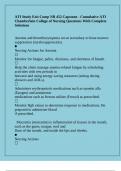ATI Study Exit Comp NR 452 Capstone - Cumulative ATI
Chamberlain College of Nursing Questions With Complete
Solutions
Anemia and thrombocytopenia occur secondary to bone marrow
suppression (myelosuppression).
■
Nursing Actions for Anemia
☐
Monitor for fatigue, pallor, dizziness, and shortness of breath.
☐
Help the client manage anemia-related fatigue by scheduling
activities with rest periods in
between and using energy saving measures (sitting during
showers and ADLs).
☐
Administer erythropoietic medications such as epoetin alfa
(Epogen) and antianemic
medications such as ferrous sulfate (Feosol) as prescribed.
☐
Monitor Hgb values to determine response to medications. Be
prepared to administer blood
if prescribed.
Mucositis (stomatitis) is inflammation of tissues in the mouth,
such as the gums, tongue, roof and
floor of the mouth, and inside the lips and cheeks.
■
Nursing Actions
☐
,Examine the client's mouth several times a day, and inquire
about the presence of oral lesions.
☐
Document the location and size of lesions that are present.
Lesions should be cultured and
reported to the provider.
☐
Avoid using glycerin-based mouthwashes or mouth swabs.
Nonalcoholic, anesthetic
mouthwashes are recommended.
☐
Administer a topical anesthetic prior to meals.
☐
Discourage consumption of salty, acidic, or spicy foods.
☐
Offer oral hygiene before and after each meal. Use lubricating or
moisturizing agents to
counteract dry mouth.
■
Client Education
☐
Encourage the client to rinse mouth with a solution of half 0.9%
sodium chloride and half
peroxide at least twice a day, and to brush teeth using a soft-
bristled toothbrush.
☐
Instruct client to take medications to control infection as
prescribed (nystatin [Mycostatin],
acyclovir [Zovirax]).
☐
,Encourage the client to eat soft, bland foods and supplements
that are high in calories
(mashed potatoes, scrambled eggs, cooked cereal, milk shakes,
ice cream, frozen yogurt,
bananas, and breakfast mixes)
Nausea and vomiting/anorexia
■
Many of the medications used for chemotherapy are emetogenic
(induce vomiting) or cause
anorexia as well as an altered taste in the mouth.
■
Serotonin blockers, such as ondansetron (Zofran), have been
found to be effective and are often
administered with corticosteroids, phenothiazines, and
antihistamines.
■
Nursing Actions
☐
Administer antiemetic medications at times that are appropriate
for a chemotherapeutic agent
(prior to treatment, during treatment, after treatment).
☐
Administer antiemetic medications for several days after each
treatment as needed.
☐
Remove vomiting cues, such as odor and supplies associated
with nausea.
☐
Implement nonpharmacological methods to reduce nausea
(visual imagery, relaxation,
, acupuncture, distraction).
☐
Perform calorie counts to determine intake. Provide liquid
nutritional supplements as
needed. Add protein powders to food or tube feedings.
☐
Administer megestrol (Megace) to increase the appetite if
prescribed.
☐
Assess for findings of dehydration or fluid and electrolyte
imbalance.
☐
Perform mouth care prior to serving meals to enhance the
client's appetite
Encourage the use of plastic eating utensils, sucking on hard
candy, and avoiding red meats
to prevent or reduce the sensation of metallic taste
Nursing Actions for Thrombocytopenia
☐
Monitor for petechiae, ecchymosis, bleeding of the gums,
nosebleeds, and occult or frank
blood in stools, urine, or vomitus.
☐
Institute bleeding precautions (avoid IVs and injections, apply
pressure for approximately
10 min after blood is obtained, handle client gently and avoid
trauma).
☐




